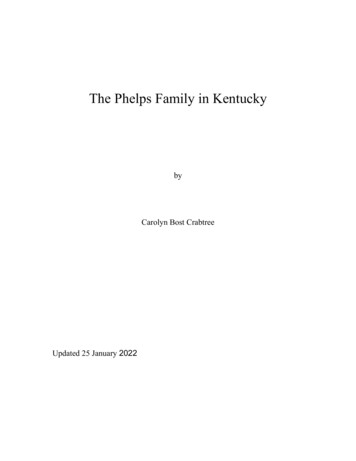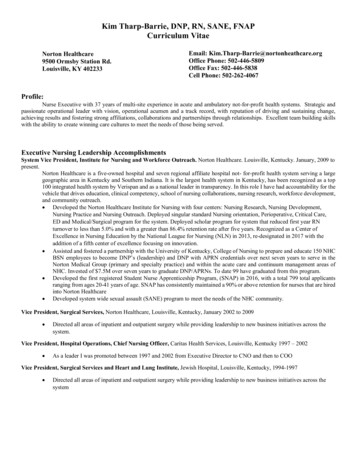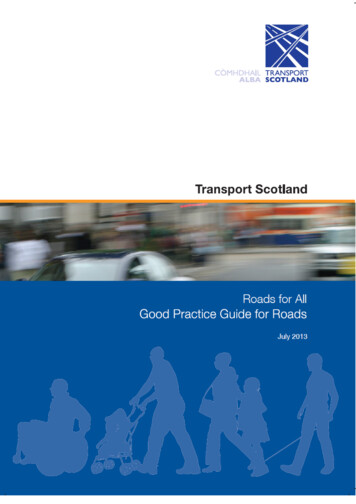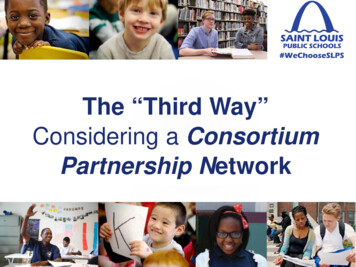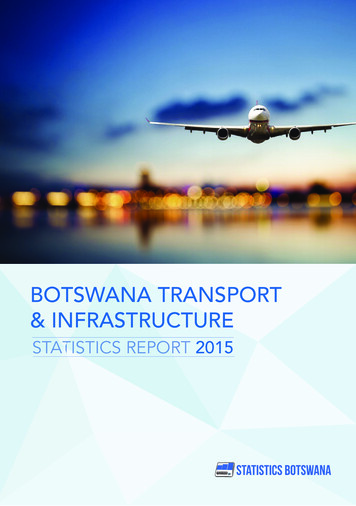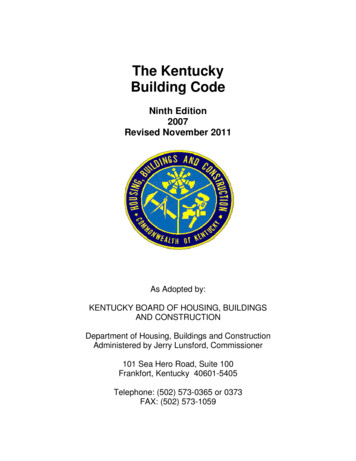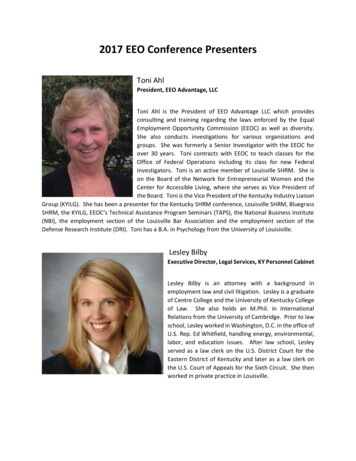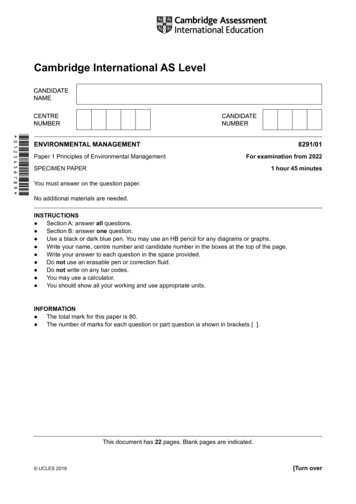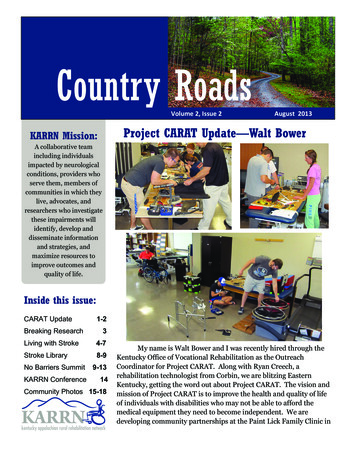
Transcription
Country RoadsVolume 2, Issue 2August 2013Project CARAT Update—Walt BowerKARRN Mission:A collaborative teamincluding individualsimpacted by neurologicalconditions, providers whoserve them, members ofcommunities in which theylive, advocates, andresearchers who investigatethese impairments willidentify, develop anddisseminate informationand strategies, andmaximize resources toimprove outcomes andquality of life.Inside this issue:CARAT UpdateBreaking Research1-23Living with Stroke4-7Stroke Library8-9No Barriers Summit9-13KARRN Conference14Community Photos 15-18My name is Walt Bower and I was recently hired through theKentucky Office of Vocational Rehabilitation as the OutreachCoordinator for Project CARAT. Along with Ryan Creech, arehabilitation technologist from Corbin, we are blitzing EasternKentucky, getting the word out about Project CARAT. The vision andmission of Project CARAT is to improve the health and quality of lifeof individuals with disabilities who may not be able to afford themedical equipment they need to become independent. We aredeveloping community partnerships at the Paint Lick Family Clinic in
CARAT ContinuedCountry RoadsPage 2Paint Lick, Premier Home Care in London, Sav-Rite Home Care in Corbin,Rockcastle County Regional Hospital in Mount Vernon, Medi Home Care inHarlan, and the White House Clinics in Appalachia. So far I have madepresentations and answered questions regarding Project CARAT at the 10thAnnual Summer Institute in Assistive Technology Conference in Frankfortand the Staff Meeting of the Bluegrass/Lexington Districts.Donations are starting to arrive from medical practitioners andcommunity members as a result of the Project CARAT initiative. Whiletraveling throughout Eastern Kentucky, we have taken in over 85 donatedmedical items, including wheelchairs, walkers, abdominal braces, quadcanes, crutches, and shower chairs. One community member donated apower chair and a hospital bed. Almost all the places we visit have medicalitems on hand they are willing to donate to Project CARAT. In addition, amember of the community in Western Kentucky has donated an adaptedvan!We have assisted with the CARAT specialty electives for the PhysicalTherapy doctoral students at the UK Center for Excellence for Rural Healthin Hazard. Carol Weber, Branch Manager for Rehabilitation Technology, andRyan conducted a workshop discussing the many different types of assistivetechnology that are currently available to consumers. James Gensch,rehabilitation technologist, and Ryan led a workshop on disassembling andreassembling manual wheelchairs. A final meeting with the physical therapystudents will include how to access the AT4ALL website and refurbishingmedical equipment. We have recently completed interviews withoutstanding candidates for the Occupational Therapist position at the Carl D.Perkins Vocational Rehabilitation Center in Thelma. Hopefully, we will havea new OT soon to coordinate CARAT activities and facilitate the refurbishingand storage of medical equipment at the Perkins Center in Eastern Kentucky.In the upcoming weeks, we have appointments with the ChristianAppalachian Project in Hagger Hill, the Director of Durable MedicalEquipment for Hospice of the Bluegrass, and a presentation for theparticipants at the Rockcastle County Senior Citizens Center in MountVernon. You can visit us next month at our partner table at KARRN’s annualconference in Richmond at Eastern Kentucky University’s campus onSeptember 25th. We will also have a table at the Kentucky Free Health ClinicAssociation annual meeting on September 26th and 27th at the downtownLexington Hilton. In addition, I am also excited to be attending the Access toCare Peer Learning Seminar, sponsored by the Office of Rural Health Policy,on October 22nd-24th in Decatur, Georgia. Please feel free to contact me bytelephone (859-246-2185, extension 275) or by email (walter.bower@ky.gov)anytime if you have input about the project, other agencies to contact,speaking opportunities, or just would like to make a donation to ProjectCARAT.
Volume 2, Issue 2Page 3Center for Clinical and Translational Science (CCTS) Supported Pilot GrantsEffects of Transvertebral Direct Current Stimulation in Humans—Lumy Sawaki, MD, PhDDrug Dosing and Traumatic Brain Injury—Ed Hall, PhDCyclosporine A (CsA), an immunosuppressant drug, has been shown to diminishthe amount of neurological loss or function in models with traumatic brain injury (TBI). Subsequently, CsA was the subject of a National Institutes of Healthclinical trial involving a larger group of “severe” TBI patients; results showed thedrug to be safe and it had some degree of effectiveness in protecting those neurons affected by the injury; investigators found that CsA produced a dosagerelated neurological improvement. The CCTS is supporting a pilot project thatsupports additional clinical trials to explore potential biological characteristics ofTBI that might serve as diagnostic indicators of the severity and timeline involved with posttraumatic brain damage. The study also seeks to identify potential theranostic indicators (or diagnostics and drug dosages unique to patients)of those that respond early to neuroprotective drug therapy, to include CsA dosing among other types of neuroprotective therapies.ResearchAccording to the National Spinal Cord Injury Statistical Center, as many as300,000 people in the United States are living with spinal cord injury (SCI).Approximately 12,000 new cases of SCI occur each year in the United States. Ithas not yet been discovered how to limit damage in early stages of SCI. Therefore, it is important to find ways to enhance motor recovery in SCI survivorsover the long term. A considerable amount of evidence shows that noninvasiveforms of brain stimulation can promote recovery of motor function in neurological populations, including SCI. Limited data exists regarding similar strategiesto stimulate the spinal cord, but evidence in this regard is promising. To expand on this evidence, we will study transvertebral direct current stimulation,or tvDCS. In tvDCS, we apply mild, painless electrical stimulation to the spinalcord through electrodes placed on the back. Our experiment will help us determine if tvDCS makes the spinal cord more receptive to motor training and gaitrehabilitation. We will study tvDCS in healthy subjects without SCI, and then,in subjects with SCI. This design will allow us to establish strong, basic sciencedata prior to rapid clinical application of our findings. This unique, groundbreaking work represents the cutting edge of advanced technology-based strategies to restore function and enhance quality of life for SCI survivors.
ResearchCountry RoadsAnne Harrison,PT, PhD is afaculty member inthe UK Division ofPhysical Therapy(College of HealthSciences)-Megan DanzlBellarmine University-Beth HunterGeorgia RegentUniversity-Violet SylviaAppalachian RegionalHealthcare System-Sarah CampbellUK SLP Program-Katie MaddyUK SLP Program-Janice KupersteinUK-DPT programPage 4Living with Stroke: Lives Turned Upside DownStroke is one of the leading causes of long-term disability. The area inthe United States that is hit the hardest with stroke is the Appalachian regionof Kentucky. This is due to a number of factors, including reduced access tomedical care, increased prevalence of chronic health problems, and reducedincome and education. Stroke can result in decreased quality of life for theperson with stroke, and caregivers can experience stress and depression.These are “lives turned up-side down” according to one person interviewedby Kentucky Appalachian Rural Rehabilitation Network (KARRN)researchers in their Needs Assessment of People with Stroke.To better understand challenges faced by stroke survivors and theircaregivers within Appalachia Kentucky, KARRN affiliates conductedinterviews with thirteen stroke survivors and twelve caregivers living in ruralAppalachia Kentucky. The interviews were broken into three categories: 1)Stroke Onset 2) Transition through the health care continuum (e.g.emergency room, to hospital, to rehabilitation units, to subacute care, tohome health) 3) Reintegration into life in their rural communities.For "Stroke Onset," participants interviewed described the initialevent as unexpected and traumatic. Most did not recognize the warningsigns and symptoms and had little to no knowledge of stroke prevention.While many spoke highly of their physicians, some noted concern about alack of depth of knowledge or expertise among rural health providers in thearea of stroke. As Larry, a stroke survivor, explained, "(The) challenge of arural community (is) gettin' medical help somebody that can recognize itand know how to treat it ”. Other challenges included the inability forparamedics to navigate to a person's home due to rural geography, lack ofneurologists, and distrust in rural medical care. Of the people interviewed,83% ultimately received their acute care from hospitals in urbancommunities. Unfortunately, the time it took to arrive at urban environmentsresulted in most missing the early windows for optimal care and preventionof expansion of the stroke.Most participants had a difficult time recalling their acute careexperience, and any education that might have been provided was typicallyforgotten due to being overwhelmed by the initial trauma of their situation.One participant, Samuel, remembered his doctors in acute care being“insensitive”, bringing in students and other doctors to view his conditionwithout any thought to his feelings on the matter. In addition, upon transferto inpatient rehabilitation, he was shocked to discover the truth of hiscondition; while in acute care, he had believed he suffered a massive heartattack, not a stroke.
Volume 2, Issue 2ResearchTo his recollection, no health care provider had explained what had actuallyhappened to him.In their transitions through the health care continuum, participantshad mixed feelings about their experiences. All but one participant movedfrom acute care to inpatient rehabilitation. While many considered thisanother frustrating hurdle before returning home, in hindsight mostappreciated the experience, which offered the tools to begin coping andadapting to their condition. Columbo considered the atmosphere, "thesunshine in the darkness," as he and other survivors were integrated into asupport system that improved their sense of self, feelings of accomplishment,and perception of recovery. Most were very positive about the care receivedfrom therapists in inpatient rehabilitation. One participant, Columbo,described a deep connection with his speech therapist. "She reached into mysoul there was just a personality connection there." Caregivers alsoexperienced varying levels of care and engagement, with some feeling wellinformed of what they would need to do to care for their loved ones, andothers feeling they remained uninformed, resulting in a sense of helplessnessand frustration.Language barriers proved to be one of the greater challenges, asproviders would inadvertently use medical lingo outside the participants'understanding, or language the participants believed to be misleading. Atleast three of the participants were told they had experienced a "smallstroke," leading them to believe they would make full recoveries. This causeddifficulty coping and a sense that their loss and change was being trivialized.One participant’s husband felt she was going crazy because she was havingmemory and speech problems due to the stroke. She was told her stroke wassmall and she never received rehabilitation after acute care. This gave herand her husband the message that she should not be having any problems,leading to serious problems and damage to their marriage.Inpatient rehabilitation is a key environment for providing essentialeducation to stroke survivors and caregivers. In one rehabilitation hospital,caregivers were invited to a "family teaching day" by inpatient rehabilitationstaff; survivors worked with providers who within a specialized stroke unitand also had the ability to interact with peers undergoing similar therapy.Although these experiences provided essential information to participants,serious drawbacks were noted by those interviewed. "Family teaching day,"which gave vital information to caregivers, was held just one day prior totheir loved ones being discharged. Most information given by providers wasoffered verbally, many times through conversations with patients, not in astructured setting for demonstration of the education. In addition,participants often felt reluctant to ask questions or simply did not know whatto ask when speaking with healthcare professionals.Page 5
ResearchCountry RoadsPage 6Living with Stroke: Lives Turned Upside Down (continued)Even with time in inpatient rehabilitation to prepare them for returninghome, most participants felt ill-equipped when they left. Many sought outcommunity-based rehabilitation (outpatient, home-based or long-termskilled nursing facilities), but could not find easy access to such services in oraround their rural hometowns. One caregiver would drive his loved one threehours, three times a week, for six months to reach an urban outpatienttherapy center. With limited access to healthcare within their communities,participants felt overwhelmed and isolated. Most considered the educationthey received in acute care and inpatient rehabilitation important butultimately lacking, especially as they tried to reintegrate back into their livesand communities.Upon returning home, problems included changed life roles,inadequate coping mechanisms and both positive and negative ruralcommunity support. As Larry explained, "People were makin' fun of me,especially my family. [The home health nurse] said they're just showin'their ignorance is all they're doin', they don't understand' she gave me abunch of literature to hand out”. Many participants would not or could notuse the written materials provided (if provided). They had difficulty recallinginformation they had received from providers, and new questions wouldarise from participants during day-to-day activities with no one there withanswers.On-going and timely education and access to healthcare providerswith in-depth knowledge about care of people with chronic stroke are twocritical issues that need to be addressed within Kentucky's Appalachiancommunities. As healthcare providers attempt to tackle these problems,however, more questions surface. When is the best time to educate patientsand their caregivers? What is the best method to deliver such information?Should this information be given repeatedly throughout the continuum ofcare and after returning home? And perhaps the most important question—who should be responsible to educate patients on what issues?Having leaders in the interdisciplinary teams in each environment ofcare coordinate which providers are responsible for what essentialinformation throughout the patient's treatment could greatly improve patientcare. Verbal methods of education were described by participants as beingoverwhelming, and one study (Garrett and Cowdell, 2005) showed apreference for verbal communication accompanied with visual models suchas pictures and videos. While research has shown that stroke survivors andcaregivers have difficulty recalling written information, when thatinformation is individualized and revisited multiple times, their recollectionof written information greatly improves.
Volume 2, Issue 2The information from this study can be found in the publication:Danzl, M.; Hunter, E., Sylvia, V. Campbell, S. Maddy, K., Kuperstein, J.Harrison, AL. Living with a ball and chain: The lived experience of stroke forindividuals and caregivers in rural Appalachian Kentucky. The Journal ofRural Health, Printed on-line ahead of print version May 23, 2013.ResearchTypically, websites are not used as a source of information by participants,possibly due to lack of computer accessibility, reduced internet services intheir communities, or the participants' inexperience with using a computeror looking up information on the internet. While this might be changing withtime and improved accessibility, providers should develop educationalstrategies that include additional alternatives to online information.In one study (Johnson and Pearson, 2000), the effects of a structurededucation course for stroke survivors living in the community (eight classesover one month) found participants had a greater sense of hope anddecreased depression from the experience. Key factors of that education thatmust be addressed include: general stroke information (what is stroke,residual effects, causes of the stroke, prognosis), the role of therapy tofacilitate recovery, how to assist functional mobility, information about thepotential of the brain to recover, prevention of secondary complications andfuture strokes, and information about accessing financial resources.In addition to the physical aspects of stroke, there are also theemotional aspects, such as depression, changing relationships, and copingstrategies, that should be addressed for stroke survivors and caregivers.What is their support system? How do they manage stress? What supportand resources do they have in their community?The current healthcare system is not well designed to provide longterm support for stroke survivors and caregivers, particularly once they havereturned to life in their rural communities. Yet the ultimate goal of peoplewith stroke and caregivers is to return home and have a decent quality of life.All participants experienced a sharp decline in support once discharged fromeither acute care or inpatient rehabilitation, leaving them to fend forthemselves after returning home. With better education methods, andimproved community support, it may be possible to improve the lives ofstroke survivors and caregivers as they learn to adapt to their new lives uponreturn to their rural communities.Page 7
ResearchCountry RoadsPage 8A Library for People with Stroke Now Availableon the KARRN Web Site—Anne Harrison, PT, PhDPeople who have suffered from a stroke and their caregivers and lovedones need ongoing support and education in order to adapt well once theyreturn to life in their communities. In fact, according to people who have hadthis experience, there is often very little education and support once theyleave inpatient acute care and rehabilitation hospitals. KARRN researcherscompleted an interview study of people with stroke and caregivers who live inrural Kentucky and named the study Needs Assessment of People withStroke (NAPS) . The NAPS study provided a voice for people with stroke andcaregivers who live in rural Kentucky to explain the challenges they facedonce they returned home to their communities. KARRN researchers alsointerviewed and surveyed health care and rehabilitation practitioners whoserve people in rural areas to determine their perspectives on the needs ofpeople with stroke once they return home to rural areas. People reportreceiving good care in inpatient environments, but because of theoverwhelming challenges of coping with “lives turned upside down” bystroke, they often are not able to remember the education they received whenthey return to their homes. The result is that at exactly the time they mostneed it (i.e. when they return home), the informational support is largely notpresent. This is particularly true in rural areas where health care and socialsupport become more difficult to access due to distance and geography(Danzl, et al 2013). In spite of receiving information on these topics in theinpatient environment, questions arise upon returning home regardingproper use of assistive devices for walking, safe approaches for assistancewith transfers, and strategies for getting up from a fall safely. As timeprogresses, concerns begin to grow regarding how to stay healthy bothphysically and emotionally. Many people voiced concerns regarding how toprevent future strokes.The purpose of our project is to provide additional educationalresources that can be accessed as videos on the internet, as DVDs for homeuse, and in the form of paper copies. UK DPT students and faculty developeda “Stroke Library” of resources designed to be easy to access, easy tounderstand, and culturally competent. Our project was formulated based onwhat we learned from the NAPS study. A desire for resources within theirown community was expressed by people with stroke, their caregivers, andrespective family members. The results of this study highlighted the needfor a compilation of resources, available in varying forms, which were easilyunderstood and accessible to people living in rural Kentucky.
Volume 2, Issue 2No Barriers Summit—Sasha RabchevskyFour representatives from our newly formed Kentucky Congress on SpinalCord Injury attended the No Barriers Summit that took place in Telluride,CO August 8-11, 2013; Sasha Rabchevsky, Bob Patterson, Micah Jackson andMyles Cope (picture below).This amazing event brought together a community of participants whoengaged their barriers andlearned to harness themfor their own good and thegood of the community.Participants experiencedthe No Barriers Mindset,focusing on developingseveral key characteristics:1) Curiosity forexploration & innovation,2) Participation in strongteams, 3) Harnessingadversity 4) Service toothers.News & EventsSuch resources could also be used by health care providers for education, andthen the resources could travel home with the patient.The KARRN Stroke Library can be accessed by visiting the KARRNweb site at www.karrn.org. The materials include hard copy and internetPDFs addressing Stroke info, Transient Ischemic strokes, Fall Prevention atHome, Depression, Fatigue, Nutrition, Pneumonia & Dysphagia, Risk Factorsand Prevention, Urinary Tract Infection, a Home Hazard Checklist, CaregiverInformation, Respite Care, Sexual Problems, and Rehabilitation. There arealso media resources available on the KARRN website. These are short videoexcerpts with audio and visual instructions on various topics includingtransfers & caregiving, bed mobility, and donning a gait belt.Whether you are a person with stroke, a family member or loved one,a professional, or just an interested community member, we would like yourfeedback on the library. When you visit the library at www.karrn.org, you willfind a link to the Stroke Library on then home page. Once you are in thelibrary, you will find a link to a brief survey. We would like to continue toenhance our materials using your feedback.Page 9
News & EventsCountry RoadsPage 10The No Barriers Summit provided technological, physical and emotionalsupport for participants with a wide variety of abilities and disabilities tostart or continue down the path of embracing the No Barriers Mindset inunique ways over the course of the 4-day event. It is a combination ofinnovation and community building as a solution for overcoming challenges.The No Barriers Summit embodies the philosophy of pushing yourselfbeyond a comfort zone, by learning and embracing innovative assistivetechnology designed to afford greater expansion of one’s ultimatecapabilities; this extends to participants who do not necessarily have aphysical disability since they witness firsthand how seeminglyinsurmountable obstacles are overcome when innovation and motivation arecombined in such a unique, inspiring venue.The event structure was centered around 3 days of outdoor adventure andarts clinics that allowed participants to try new physical activities with acommunity of volunteer supporters to help make the activities accessible totheir many differentability levels. Theseclinics included (butwere not limited to)rock climbing, off-roadwheelchair racing,adaptive hiking, biking,photography,filmography, painting amural, tennis, golf, etc.Then each eveningsession consisted ofscientific presentationsby innovative experts as well as extraordinary disabled end-users ofinnovative adaptive equipment who shared stories of success and showcasingleading technological solutions to barriers.Whether or not participants had a disability or were loved ones and/or careproviders, everyone at the Summit was immersed in the company ofpioneering, innovative individuals who either develop assistive technologiesto overcome barriers or are courageous trial users of such innovationsdesigned to overcome obstacles that prevent engagement in physicalactivities that may otherwise appear infeasible.
Volume 2, Issue 2Highlights of Speakers/Performers:Mandy Harvey is a deaf American jazz singer and songwriter. A Vocal MusicEducation major at Colorado State University, Mandy lost her hearing in2006-2007 at age eighteen and left. She pursued several career options,including education, but returned to music in 2008. She is now an acclaimedperformer and has maintained perfect pitch despite her hearing loss. Hersinging was truly inspirational, knowing that she cannot hear her own voice!?Bob Woodruff was the keynote speaker. He is an award-winning televisionjournalist whose noted career with ABC News began in 1996. His intrepidreporting has taken him from the Afghanistan and Iraq wars to the unrest inMiddle East/North Africa, to North Korea during its 2010 celebration of the65th Anniversary of the Workers Party. In January of 2006, while reportingon U.S. and Iraqi security forces, Woodruff was seriously injured by aroadside bomb that struck his vehicle near Taji, Iraq. In an instant, his lifewas altered forever. He suffered a severe brain injury and was in a coma forover a month.Erik Weihenmayer, co-founder of No Barriers, has become a celebrated andaccomplished athlete despite losing his vision at the age of 13. Redefiningwhat it means to be blind, Erik has transformed the image of blindness andopened up the minds of people around the world. On May 25, 2001, Erikbecame the first blind climber in history to reach the summit of the world’shighest mountain, Mount Everest. At the age of 33, he became one of lessNews & EventsUnfortunately, Micah Jackson was seriously injured during his downhill 4cross cycling and broke his clavicle and shoulder blade the 2nd day of thesummit. However, with the support of the NoBarriers staff and board, including Soldiers toSummit participants, Micah was well taken careof and was even escorted to the airport in awheelchair and van donated by the TellurideAdaptive Sports Program to get him to hisrearranged flights back to Lexington. He was alsoaccompanied during his entire flight exchangesby a wonderful volunteer and newfound friendfrom Soldiers to Summits, Karen Diener!!! Micahis now recovering comfortably at home inLexington.Page 11
News & EventsCountry RoadsPage 12than 100 individuals to climb all of the Seven Summits – the highest peakson each of the seven continents.No Barriers presented for thefirst time two exoskeleton userson the same stage! Exoskeletontechnology has been referred toas a “wearable robot.” Thispowerful external skeleton isbringing the brink of moderntechnology to the lives of thoseaffected by paralysis. It isredefining what is possible formany users. In this excitingpresentation, moderator SashaRabchevsky, Ph.D. and exoskeleton expert Russ Angold helped the audienceto better understand the history, present and future of this excitingtechnology.Everyday users, Amanda Boxtel and Mitch Brogen each shared their personaljourneys from the wheelchair to the exoskeleton and demonstrated the affectit has had on them as they showcase the technology. Amanda Boxtel, aparaplegic in a wheelchair for 21 years, demonstrated the Ekso exoskeletonwhich enables her to walk upright. Importantly, the existing technology israpidly advancing. Speakers equated its progress to the once bulky cellphones which today are miniaturized with many applications. It was quiteemotional when Amanda looked down at her audience, many in wheelchairs,and said, "For those of you in wheelchairs get ready to walk." How powerfulis that? They were available for one-on-one Q&A immediately following theNBU presentation in the Innovation Village Bazaar.Kyle Maynard, born with no limbs, who had tried climbing for the first timeat our 2011 Summit, later perfected a technique that worked for him, andthen went on to climb Kilimanjaro last year, along with winning the ESPYaward for disabled athlete of the year. He gave us his thoughts aboutperseverance. "If you're not dead, keep going!"Dr. Hugh Herr, a double-leg amputee himself, co-founder of No Barriers anda professor at Harvard/MIT, has developed the most sophisticated knee andankle prostheses in the world. Hugh predicted at No Barriers University thatmost disabilities would be eliminated by technology by the end of thiscentury. Pretty bold statement.and exciting .he received the No Barriers
Volume 2, Issue 2Page 13Lifetime Achievement award!Of course, solutions require pioneering and a No Barriers mindset, but theyalso require money. We are very proud to report that Erik Weihenmayercompleted his 1million pledge toNo Barriers fromhis speakingengagements,which promptedan existingsupporter to makea 1 milliondonation whichonly needs to bematched with newgifts to NoBarriers USA.What a finale!News & EventsJen French is a quadriplegic and a competitive sailing athlete who recentlymedaled at the 2012 Paralympics Games in London. Ms. French is theExecutive Directorof NeurotechNetwork and authorof the book, On MyFeet Again: MyJourney Out of theWheelchair UsingNeurotechnology.She was aparticipant in aclinical trial of aneuroprostheticsystem that enables her to stand up outside of her wheelchair to movearound on her own two feet using her own muscles, stimulated by 24surgically implanted electrodes. In 2012, Jen became the first woman with adisability to be awarded the U.S. Sailing’s Rolex Yachtswoman of the Year.
Upcoming EventsCountry RoadsPage 145th Annual K
-Beth Hunter Georgia Regent University -Violet Sylvia Appalachian Regional Healthcare System -Sarah Campbell UK SLP Program -Katie Maddy UK SLP Program -Janice Kuperstein UK-DPT program . Volume 2, Issue 2 Page 5 Research To his recollection, no health care provider had explained what had actually


